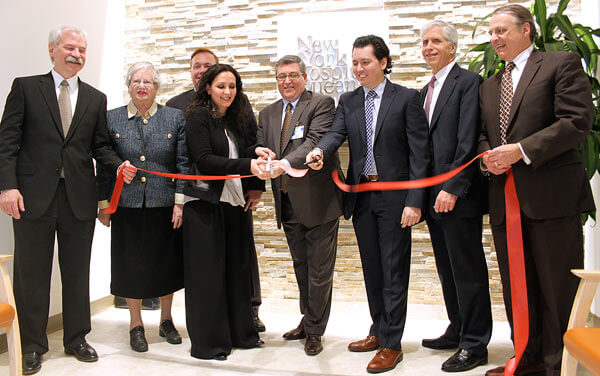By Joe Anuta
New York Hospital Queens cut the ribbon on its first community-based practice Tuesday night in Whitestone, heralding a new phase of expansion in a borough where many other health care facilities have failed.
Dr. Stephen Rimar, chief medical officer at NYHQ and Stephen Mills, president and chief executive officer, were joined by doctors and lawmakers who welcomed the new primary care, internal medicine and cardiology facility near the corner of 150th Street and 14th Avenue. Doctors Ambrose Pipia, Domenick Acquista and Katherine Heretis will be the first to practice at the facility, but they will be joined by additional physicians throughout the year, according to the hospital.
The Tudor-style exterior of the facility exudes the small-town vibes Whitestone residents cherish, but the sleek interior is decidedly state of the art. The facility is the first of many offices the hospital hopes to open and comes on the heels of another massive expansion.
In 2010, the hospital, whose main building is on the corner of Main Street and Booth Memorial Avenue, cut the ribbon on a new wing that added more than 190,000 square feet to the facility as part of a $200 million modernization program.
That same year the hospital, a nonprofit affiliated with the New York-Presbyterian Healthcare System, reported a budget surplus in the millions, according to filings with the state Department of State.
An annual report published in 2011 read, “New York Hospital Queens finished 2011 in a strong position, despite continued turmoil in the economy and questions about the prospects of some other health care facilities in this area.”
Some of those questions have been answered.
Four hospitals in Queens have closed since 2008: Parkway, St. John’s, Mary Immaculate and Peninsula. Three of those closures were due to bankruptcy.
Health care costs are rising all over the country, but some of the challenges of operating a medical facility in New York City include caring for the uninsured.
In 2010, NYHQ’s costs for uncompensated care ran $35.7 million, according to Department of State filings.
And uninsured or not, many people use emergency room and hospital physicians as if it were their primary care doctors, which can lead to overcrowding.
But according to Rimar, the borough is not facing a shortage of beds so much as a shortage of doctors.
“If you have primary care, you’re less likely to be admitted to a hospital,” he said. “We’re making an investment in this.”
By opening more offices like the Whitestone primary care facility, which operates like a private practice but has access to all the facilities and expertise of the hospital at large, NYHQ hopes to deliver services in a way that benefits the borough by providing care locally, while at the same time prevent unnecessary visits to the main facility.
City Councilman Dan Halloran (R-Whitestone) and state Sen. Toby Stavisky (D-Whitestone) praised the new Whitestone clinic.
“If a facility such as this keeps people out of the emergency room, everybody benefits,” Stavisky said. “It’s a lot cheaper to come here than go to the ER.”
Reach reporter Joe Anuta by e-mail at januta@cnglocal.com or by phone at 718-260-4566.


































